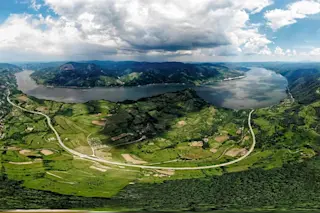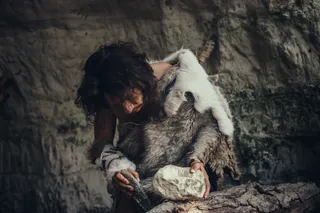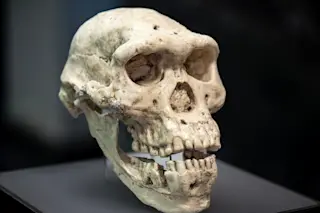The barrel-chested man is known to us only as Burial 7/I. His 8,000-year-old remains were found at a fishing camp that hugs a curve in the Danube River as it winds through southeastern Europe, on its way to the Black Sea.
For most of his life, he stalked red deer in dense forests and wrestled sturgeon from whirlpools in the churning river. But later in life, he seemed to turn away from the hunter-gatherer life of his ancestors and toward that of a settled agriculturalist.
Burial 7/I, according to some of the archaeologists who have studied him, was born a hunter and died a farmer — though other researchers dispute that. It’s just one of the questions that linger over this stretch of the Danube, where archaeological finds are revealing details of an unprecedented encounter between traditional European hunter-gatherers and early farmers moving into the area from the south.
Since the 1960s, at these sites where the Danube forms the border between Serbia and Romania, archaeologists have turned up artifacts and human remains that are 7,900 to 8,200 years old. The sites here represent the oldest examples in Europe of interaction between farmers and foragers during the region’s Neolithic transition, when the semi-nomadic hunter-gatherer lifestyle that had persisted for millennia was replaced with agricultural communities. That transition, which occurred at different times in different places, changed the course of humanity.
“It is probably the most exciting period in history that I am aware of,” says Joachim Burger, an archaeologist and population geneticist at Mainz University in Germany.
The sites offer a glimpse of the everyday life of people living at this time of momentous transition. And thanks to analysis of Burial 7/I and other remains through ancient DNA sequencing and other methods, researchers are uncovering more details — and more mysteries — about the individuals who called this bend in the river home.
Ancient DNA analysis has established that the arriving farmers were most closely related to people living in northwestern Anatolia, or the Asian part of modern Turkey. Agriculture had been a way of life for them for thousands of years. It had spread from the Fertile Crescent in the southeast, a region that today includes Iran and Iraq.

The skeleton known to archaeologists as Burial 7/I was interred 8,000 years ago along the Danube River with an additional human skull, as well as the skull of an auroch (a type of wild cattle). Institute of Archaeology, Belgrade
The Anatolians arriving at the Danube’s banks to farm were not the first to get their hands dirty in European fields. Hundreds of miles to the south, by the Aegean Sea in southern Greece, agriculturalists were reaping and sowing 500 years before the Anatolians showed up. But there is scant evidence that those earlier farmers interacted with local hunter-gatherers.
Before the fifth millennium B.C., or 7,000 years ago, farmers and foragers rarely crossed paths; examination of burial remains shows genetic separation, says Burger. “They probably saw each other from a distance occasionally and just stared at each other, thinking, ‘Oh, those strange people.’ ”
Whether farmers or foragers, groups were small and scattered, dwarfed by the limitless European landscape. In addition, they sought different environments, says Stephen Shennan, an archaeologist at the University College London and author of the book The First Farmers of Europe. Foragers opted for forests and mountains full of game, or rivers and coasts teeming with fish. Farmers chose flatland with fertile soil in temperate climates.
And yet, against all odds, here along the Danube, contact happened. “It is something very special and doesn’t represent the norm at all,” says Shennan.
Fishermen Foragers
Home to scores of prehistoric settlement sites, this nearly 100-mile stretch of river is known as the Iron Gates region, named after two dams built decades ago. Just as the Danube is a resource for modern populations, it sustained the hunter-gatherer bands that lived there more than 8,000 years in the past.
While many forager groups in other parts of the world moved with the seasons, hunting game and gathering plants, Iron Gates bands stuck close to the river valley. Excavations of their encampments reveal large amounts of fish bones; dietary clues preserved in the foragers’ bones showed heavy fish consumption.

Neolithic farmers migrating out of Anatolia brought their way of life to a corner of southeastern Europe. The region, rich in archaeological sites, is now known as the Iron Gates, named after Cold War-era dams erected along the Danube River there. Alison Mackey/Discover
Their favorite catch was apparently sturgeon, some specimens longer than a man, as they swam upriver in spring from the Black Sea to breed and spawn. The activity required planning, and it was a group effort: Parties would have used boats, nets, harpoons and stone mallets for clubbing, says Columbia University archaeologist Dušan Bori, who has excavated Iron Gates sites. Favorite fishing spots would have been the river’s whirlpools, where the currents confused the animals and made them easy prey — and a protein-rich staple.
Sofija Stefanovi, an anthropologist at the University of Belgrade, says that based on her bone analyses of many Mesolithic remains at Iron Gates, the foragers were healthy with no signs of malnutrition. “Their diet in the Mesolithic was actually perfect,” she says. “In many cases, they lived quite long, 50 to 60 years.”
First Contact
Besides eating a diet of mostly fish, the foragers looked physically different from the farmers. Remains from Iron Gates reveal the male hunter-gatherers, on average, were more muscular and about a head taller than the male farmers, though women from both cultures were about the same height.
The farmers likely traveled from Anatolia along the Black Sea coast to the Danube peninsula, where they turned upriver and into the heart of southeastern Europe. Upon arrival, they probably aimed to befriend the locals, a common practice of migrants entering an inhabited territory, says University of Kansas archaeologist Ivana Radovanovi, who studies Iron Gates. They’d want to be on good terms to pick the foragers’ brains about the region.
This could have ended badly, given other outcomes in human history. In the 1500s, the arriving Spanish in Mexico wiped out the Aztec and Incan empires. The Pilgrims in New England were friends with Native Americans, until they weren’t.
But at Iron Gates, farmers and foragers got along. Human remains unearthed at the numerous sites have no battle wounds or other injuries consistent with full-scale conflict. “The evidence shows that these two populations were relatively peaceful in their interactions, rather than killing each other or [attacking] each other,” says Bori. “I would not exclude the possibility of outbursts of violence, but there is no systematic violence of one population on the other.”

Prince Parise
There are a number of reasons why the hunter-gatherers may have been friendly toward the new arrivals. For example, they might not have viewed the migrants as a threat. At least initially, the foragers outnumbered the migrants. A 2015 paper in Archaeological and Anthropological Sciences placed the river valley’s hunter-gatherer population in the hundreds. No warrior invasion here. And the migrants’ interest was agriculture, not muscling a netted sturgeon out of a whirlpool. So territorial conflicts were unlikely.
Still, the foragers’ receptiveness also could have been something else entirely: They were already aware of the farming way, to some extent.
Vast trade networks linked the foragers with regions perhaps as far away as Greece, as indicated by exotic items found at Iron Gates: seashell beads from the Black Sea and tools made of volcanic obsidian mined from an island in the Aegean Sea. In fact, hunter-gatherers of the era were no strangers to networking. “Their trade connections were massive and probably still underestimated,” says Burger.
Crops may have been among the items traded. According to a paper published in 2016 in the journal PNAS, Iron Gates hunter-gatherers were eating domesticated wheat and barley as early as 8,600 years ago, more than 400 years before the Anatolian farmers arrived. Researchers discovered starch granules in the tooth plaque of some of the foragers. The starch, they contend, came from domesticated grains not grown in the region.

Limestone beads found in an Iron Gates grave. Dusan Boric
Trading for crops before embracing agriculture is common. North American foragers traded for domesticated maize for hundreds of years prior to cultivating it themselves, the paper points out. Still, some scientists want to see more evidence. Mirjana Roksandic, a University of Winnipeg anthropologist who has excavated at Iron Gates, isn’t convinced that wild and domesticated starch grains can be distinguished from each other in tooth plaque.
One fact not disputed among researchers: The farmers and foragers eventually shared their cultures. Both groups saw benefits to it, says Burger. The foragers had a generous food supply, which intrigued the farmers. And the foragers were open to learning about food production. Within a few generations, ancient DNA shows, the two groups were having sex and raising families. “For people to marry into another population, there must be a high economic attraction underlying this process,” says Burger. “Otherwise, you wouldn’t do it. It’s not like you fall in love and it’s a romantic story. You are attracted because you think you can have a better life.”
A Cultural Potpourri
Among the Iron Gates settlements is Lepenski Vir, named after the whirlpool at its doorstep. (Vir means “whirlpool” in Serbian.) Perhaps only a few dozen people occupied it at any one time, according to the paper in Archaeological and Anthropological Sciences. But many people were buried there: Nearly 200 human remains have been recovered, some beneath buildings.
From about 9,500 years ago, when only hunter-gatherers lived in the area, to about 7,500 years ago, when Iron Gates was the sole domain of farmers, Lepenski Vir was variously a fishing camp, a social destination, a settlement, a burial site and perhaps a spiritual center. It might have been all or a combination during some periods. The river site offers a wealth of evidence for cultural exchange during the transition.

Lepenski Vir, a key site for Neolithic foragers and farmers, was relocated in 1971 during dam construction to avoid being flooded; it‘s now protected from the elements on a hillside above the whirlpool for which it was named. Mita Stock Images/Shutterstock
Consider how the bodies were buried. In southeastern Europe, hunter-gatherers buried their dead on their backs with hands usually placed on the stomach and legs straight. Anatolian farmers buried their dead on their sides in a curled position.
This all gets jumbled at Lepenski. Several people with DNA matching Anatolian farmers were buried in the hunter-gatherer manner; curled burials appeared at the tail end of the transition, about 8,000 years ago.
The decorative items the two groups wore also became mixed up. Foragers adorned themselves with disk-shaped beads like those worn by Anatolians, while forager beads made from mollusks vanished from the archaeological record. Other evidence shows that farmers brought with them more than just agriculture. Shards of pottery, the first found in the area, and bones of domesticated animals — including goats, cattle and pigs — have been recovered.
The foragers also changed their diet. Bone collagen analysis reveals they were consuming less fish and more grains and meat, like the farmers in Anatolia.
The Last Forager
Ancient DNA and artifacts aren’t the only means to tell the story of Iron Gates. Scientists can determine migration patterns by measuring strontium isotope ratios in tooth enamel, which forms in early childhood. Unlike genetic material, tooth enamel is generally impervious to degradation after death. Strontium comes from weathering rocks, and it ends up in water and food, seeping into tooth enamel layers. The molecular particles are a signature of a geographic region and indicate where someone lived in youth. If someone were born in northern Greece or Anatolia, the strontium signal would be different from that of Iron Gates natives.
Scientists have long suspected that Danube foragers and their farming neighbors gathered at Lepenski Vir to exchange stories and ideas, and probably to find mates. The strontium analysis, published in a 2013 PNAS paper, supports this idea. Of the 45 remains tested, 10 belonged to women who came from Anatolia, presumably as part of the farming communities — a head-turning number in what is essentially a forager settlement. Adding to the mystery, three of those women were buried in the hunter-gatherer manner.
The discovery suggests the casual manner in which farming spread, says Bori, co-author of the paper. “It is very likely that Neolithic women coming into the forager settlements spread [farming] skills,” he says.
Lepenski Vir’s most intriguing human burial is that of 7/I — the large-framed man, likely in his 50s, that some researchers believe was born a hunter and died a farmer. He was laid to rest beneath a building’s plaster floor, with the detached skull of another individual placed over his left shoulder.

Two different styles of burial at Lepenski Vir and other sites in the region reflect the disparate cultures merging into one. Foragers native to the area buried their dead on their backs, but farmers arriving from Anatolia laid them to rest on their side, knees pulled toward elbows. Prince Parise
Researchers examined collagen from the man’s right femur and a rib, according to a study published in 2015 in Radiocarbon. The femur, which stops replacing collagen usually in early adulthood, suggested a diet primarily of fish, typical of Iron Gates foragers. The rib, however, indicated a farmer’s grain and meat-heavy diet. Collagen in a rib is continually replaced, so it suggests a person’s diet in their final years, says Clive Bonsall, lead author and an archaeologist at the University of Edinburgh.
Rather than feasting on, say, a plate of catfish in the years before his death, Burial 7/I might have spooned up calorie-rich porridge, a mix of cereals and goat’s milk. Here was the Neolithic transition embodied in one person.
Despite the dietary turn, the ways of his ancestors didn’t completely escape him: The man was laid to rest on his back, body straight, palms on his belly.
The conclusions in the Radiocarbon study are controversial. Originally excavated in the 1960s, Burial 7/I’s remains have been moved to different storage locations and sometimes mishandled, says Roksandic, who examined the skeleton in the late 1990s and is the paper’s co-author. Contamination is possible, she acknowledges. But Bonsall says bone collagen is relatively resistant to postmortem alteration. He hopes that future analysis of the skeleton’s DNA and teeth will answer questions raised by colleagues.
By the time the man died, about 8,000 years ago, hunter-gatherer culture was in its twilight at Iron Gates. “It takes not more than 300 years, and the whole area is full of farmers,” says Burger. “The hunter-gatherers have been replaced.”
Farmer Boom
Before the foragers were fully absorbed into the farming communities, however, Lepenski Vir appears to have been the region’s first multicultural nexus. “That might have contributed to the creativity we see at the site, and what makes the site so important,” says Bori.
Within hundreds of years of first contact in Iron Gates, complex agricultural societies sprang up in southeastern Europe, along with other advances, such as intricate metalwork.
Meanwhile, agriculture was also spreading outside southeastern Europe. By the middle of the sixth millennium B.C., some 400 years after Burial 7/I, farming was in central Europe and on the Iberian Peninsula, according to a paper published in Nature in February. By the end of that millennium, agriculture had reached Eastern Europe, which included farming settlements in the Ukraine of hundreds of people.
The swiftness of the agricultural revolution makes the interaction at Iron Gates all the more interesting. An ancient subsistence strategy was starting to vanish. A cultural watershed, perhaps the most significant in human history, was underway. Change was happening on an unprecedented level. But from the viewpoint of an individual living through it, the transition was pretty casual — manifesting, on occasion, as foragers and farmers talking shop above the thrum of a river.















